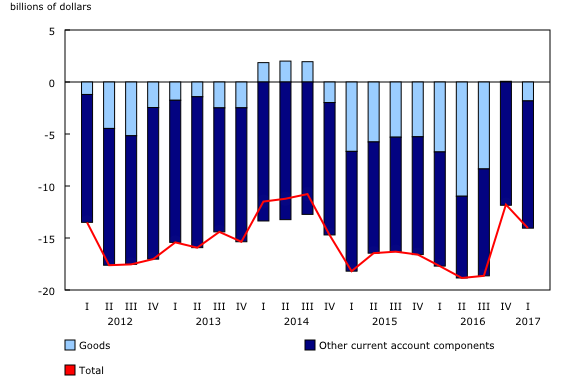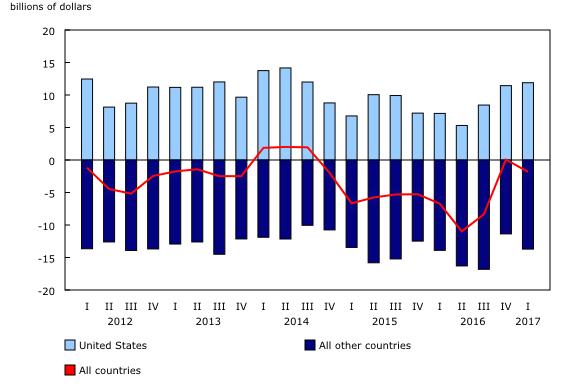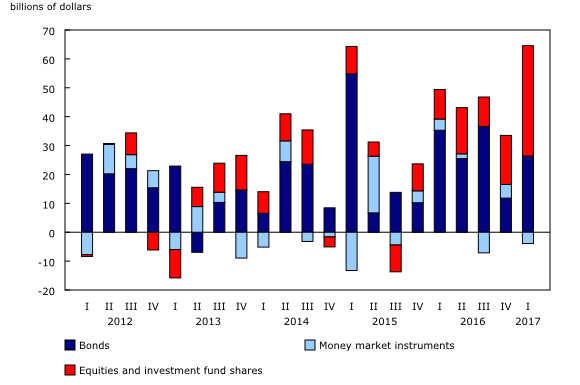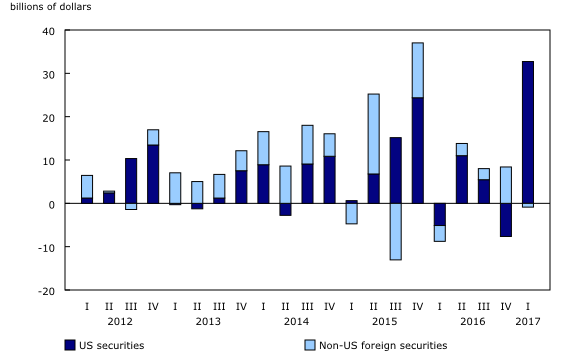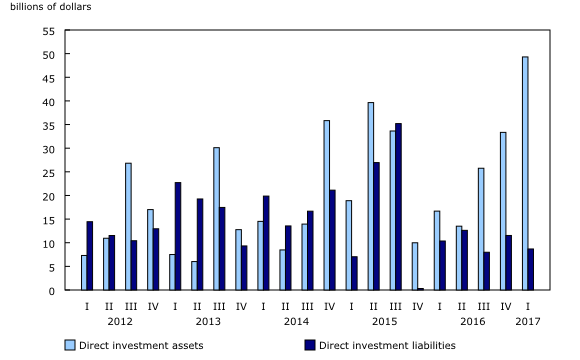Canada's balance of international payments, first quarter 2017
Archived Content
Information identified as archived is provided for reference, research or recordkeeping purposes. It is not subject to the Government of Canada Web Standards and has not been altered or updated since it was archived. Please "contact us" to request a format other than those available.
Released: 2017-05-30
-$14.1 billion
First quarter 2017
Canada's current account deficit (on a seasonally adjusted basis) widened by $2.3 billion in the first quarter to $14.1 billion, as the goods balance moved from a surplus to a deficit.
In the financial account (unadjusted for seasonal variation), large foreign investment in Canadian corporate securities led the net inflow of funds into the economy.
Current account
The goods balance posts a deficit following a modest surplus
The balance on international trade in goods posted a $1.8 billion deficit in the first quarter, following a $0.1 billion surplus in the previous quarter.
On a geographical basis, the goods deficit with non-US countries was up $2.3 billion, mainly reflecting higher deficits with Brazil, Netherlands, Germany and Hong Kong. Meanwhile, the surplus with the United States, led by stronger exports of energy products, increased $0.5 billion in the first quarter.
Total exports of goods rose $2.2 billion to $138.5 billion in the first quarter. Energy products, led by crude petroleum, were the major contributor, with exports up $2.5 billion as prices reached their highest level since the end of 2014.
Total imports of goods were up $4.0 billion to $140.3 billion in the first quarter, as both energy products and motor vehicles and parts had increases of over $1 billion.
Trade in services deficit grows
The overall deficit on international trade in services rose $0.3 billion in the first quarter to $5.7 billion as the commercial services surplus went down.
In the first quarter, imports of commercial services edged up $0.2 billion while exports were unchanged. The deficit on transport services increased slightly, reflecting higher payments of water transport. Travel deficit also marginally increased to reach $3.7 billion, as higher receipts from US travellers were more than offset by larger payments by Canadian travellers visiting the United States.
Deficit on investment income up slightly
The investment income deficit, the difference between incomes generated on Canada's international assets and liabilities, edged up $0.2 billion to $5.4 billion in the first quarter.
Higher interest paid on foreign currency deposits held by non-residents in Canada contributed to the increase in the investment income deficit for the quarter.
Profits earned by Canadian direct investors on their assets abroad were up $0.3 billion despite lower dividend receipts. This increase was moderated by lower interest receipts on inter-company debt claims. On the payment side, profits earned by foreign direct investors on their Canadian assets were unchanged.
Financial account
Foreign investment in Canadian securities reaches a record high
Foreign investors increased their holdings of Canadian securities through a record high investment of $60.7 billion in the first quarter, following acquisitions of $33.5 billion in the previous quarter. The investment activity was largely in Canadian corporate securities, as foreign investors reduced their exposure to government securities in the quarter.
Foreign acquisitions of Canadian equities reached $38.2 billion in the first quarter, the largest investment ever recorded. Issuances of new Canadian shares to non-resident portfolio investors resulting from cross-border mergers and acquisitions led the investment activity.
Foreign investment in Canadian bonds amounted to $26.4 billion, led by acquisitions of corporate bonds. The largest foreign divestment in federal government bonds in more than 13 years moderated the overall inflows in the quarter. At the same time, non-resident investors withdrew $3.9 billion of funds from the Canadian money market. The decline was mainly in provincial government paper and, to a lesser extent, federal government paper. Canadian long-term interest rates were down by 14 basis points in the quarter after a large increase in the fourth quarter.
Canadian investment in foreign securities increases significantly
Canadian investors acquired $31.9 billion of foreign securities in the first quarter, up significantly from a $0.7 billion investment in the previous quarter. The activity in the quarter was led by large purchases of US instruments, moderated by sales of non-US foreign securities.
Canadian investors increased their holdings of foreign shares by a record $26.2 billion. This activity reflected acquisitions of $28.8 billion of US shares in the quarter, mainly in March. Investors also added foreign debt securities to their portfolios, largely in the form of US government instruments.
Direct investment abroad hits a record
Direct investment abroad totalled $49.3 billion in the first quarter, the highest value on record. The investment was entirely in the form of equity instruments, with over three-quarters resulting from merger and acquisition activities in the United States. On a sector basis, the bulk of the investment in the quarter was in the trade and transportation industry.
Direct investment in Canada slowed to $8.7 billion in the first quarter, continuing low levels of investment recorded since the fourth quarter of 2015. Equity investment made by foreign parents in Canadian affiliates accounted for all of the investment, as there was a reduction in debt liabilities of Canadian affiliates to their foreign parents. More than half the direct investment in Canada was in the form of reinvested earnings.
Other investment generates a net inflow of funds
The other investment category of the financial account generated a net inflow of $26.4 billion in the first quarter. A reduction in currency and deposits held abroad by Canadians led the activity.

In celebration of the country's 150th birthday, Statistics Canada is presenting snapshots from our rich statistical history.
Estimates of the Canadian balance of payments by the Dominion Bureau of Statistics first made their appearance in 1928, with the publication of a report covering the years 1920 to 1926. In subsequent publications, the year 1926 was considered as the first covered by official estimates.
It was not until 1953 that the quarterly estimates of the Canadian balance of payments were sufficiently developed to warrant regular publication. Estimates from the first quarter of 1946 were then published. This was the beginning of a continuing production of relevant quarterly estimates.
Note to readers
Definitions
The balance of international payments covers all economic transactions between Canadian residents and non-residents in three accounts: the current account, the capital account and the financial account.
The current account covers transactions in goods, services, compensation of employees, investment income and secondary income (current transfers).
The current account data in this release are seasonally adjusted. For information on seasonal adjustment, see Seasonally adjusted data – Frequently asked questions.
The capital account covers capital transfers and transactions in non-produced, non-financial assets.
The financial account covers transactions in financial assets and liabilities.
In principle, a net lending (+) / net borrowing (-) derived from the sum of the current and capital accounts corresponds to a net lending (+) / net borrowing (-) derived from the financial account. In practice, as data are compiled from multiple sources, this is rarely the case and gives rise to measurement error. The discrepancy (net errors and omissions) is the unobserved net inflow or outflow.
For more information on the balance of payments, consult the Frequently asked questions section in the System of macroeconomic accounts module of our website. The module also presents the most recent balance of payments statistics.
Real-time CANSIM table
Real-time CANSIM table 376-8105 will be updated on June 5. For more information, consult the document, Real-time CANSIM tables.
Next release
Balance of international payments data for the second quarter will be released on August 30.
Products
The document, " Treatment of duties applied to imports of Canadian softwood lumber products into the U.S. " (13-605-X), is available from the Browse by key resource module of our website, under Publications.
The Methodological Guide: Canadian System of Macroeconomic Accounts (13-607-X) is available.
The User Guide: Canadian System of Macroeconomic Accounts (13-606-G) is also available. This publication will be updated to maintain its relevance.
Contact information
For more information, contact us (toll-free 1-800-263-1136; 514-283-8300; STATCAN.infostats-infostats.STATCAN@canada.ca) or Media Relations (613-951-4636; STATCAN.mediahotline-ligneinfomedias.STATCAN@canada.ca).
To enquire about the concepts, methods or data quality of this release, contact Denis Caron (613-808-2278; denis.caron@canada.ca), International Accounts and Trade Division.
- Date modified:


